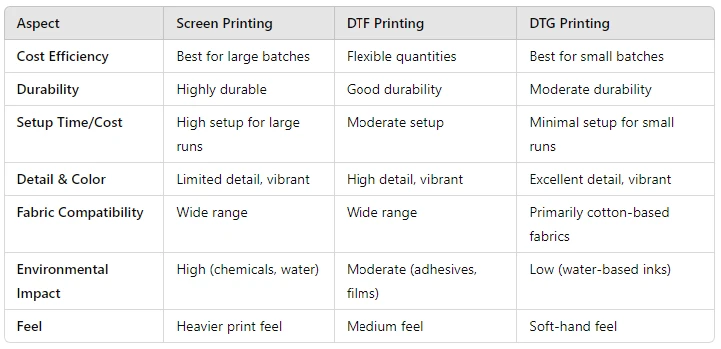DTG vs DTF vs Screen Printing
Comparing Screen Printing, DTF, and DTG: Which Method is Right for You?
When it comes to custom printing on textiles, three main methods stand out: Screen Printing, Direct to Film (DTF) Printing, and Direct to Garment (DTG) Printing. Each method has its own set of advantages and disadvantages, making it suitable for different needs and applications. In this blog post, we'll explore these three printing techniques and help you decide which one is best for your project.
Screen Printing
Pros:
-
Cost-Effective for Large Batches: Ideal for bulk orders due to the lower cost per unit with higher quantities.
-
Durability: Produces long-lasting prints that can withstand numerous washes without significant fading.
-
Versatility: Works on a wide range of materials, including textiles, plastics, wood, and metal.
-
Vibrant Colors: Achieves bright, opaque colors, especially on dark fabrics.
Cons:
-
Setup Time and Cost: Requires creating screens for each color, which is time-consuming and costly for small orders.
-
Limited Detail: Not ideal for designs with intricate details or high color variability.
-
Environmental Concerns: Uses significant amounts of water and chemicals, raising environmental impact concerns.
-
Bulk Production: Less efficient for small orders or one-off items.
Direct to Film (DTF) Printing
Pros:
-
Versatility: Can print on a wide variety of fabrics, including cotton, polyester, nylon, and blends.
-
No Pre-Treatment Needed: Unlike DTG, DTF does not require fabric pre-treatment.
-
Detail and Color: Capable of producing high-detail and vibrant prints.
-
Durability: Offers good durability, with prints that can handle regular washing without significant degradation.
Cons:
-
Complex Process: Involves multiple steps, including printing, powder application, and curing.
-
Specialized Equipment: Requires specific printers and materials (transfer films and powders).
-
Environmental Concerns: The use of adhesive powders and films can have environmental impacts.
-
Texture: Can sometimes leave a heavier feel on the fabric compared to DTG and screen printing.
Direct to Garment (DTG) Printing
Pros:
-
High Detail and Color Range: Excellent for printing detailed and colorful designs, including photographic prints.
-
Quick Turnaround: Ideal for small batches and one-off prints due to minimal setup time.
-
Eco-Friendly: Uses water-based inks, which are more environmentally friendly.
-
Soft Hand Feel: Produces a soft print that is integrated into the fabric rather than sitting on top.
Cons:
-
Costly for Large Orders: More expensive per unit for large production runs compared to screen printing.
-
Fabric Limitation: Best suited for cotton and cotton-blend fabrics; not as effective on synthetic materials.
-
Durability: Less durable than screen printing, especially with frequent washing.
-
Pre-Treatment: Requires pre-treatment of fabrics to achieve optimal print quality and durability.

Conclusion
Choosing the right printing method depends on your specific needs. If you're looking for a cost-effective solution for large batches, screen printing might be the way to go. For versatility and high-detail prints, DTF printing is a solid choice. DTG printing excels in producing detailed, vibrant prints with a soft feel, making it ideal for small orders and intricate designs.
Consider the nature of your project, your budget, and the fabric you're working with to make an informed decision. Each method has its unique strengths, so understanding these can help you achieve the best results for your custom printing needs.